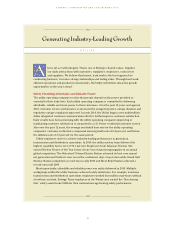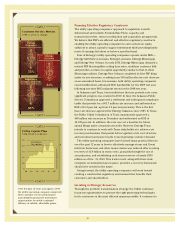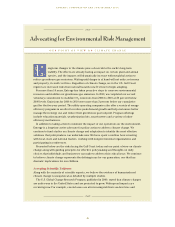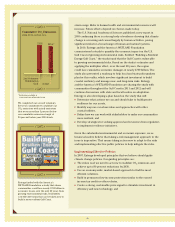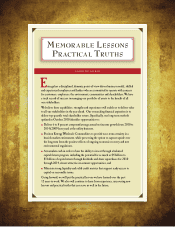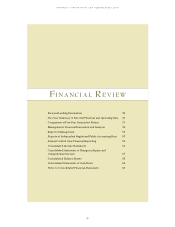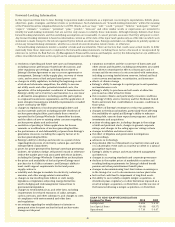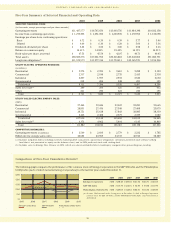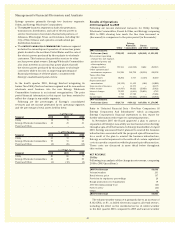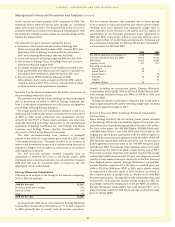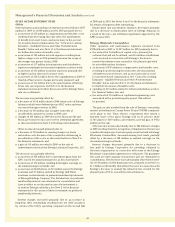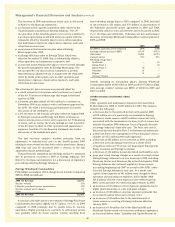Entergy 2010 Annual Report Download - page 29
Download and view the complete annual report
Please find page 29 of the 2010 Entergy annual report below. You can navigate through the pages in the report by either clicking on the pages listed below, or by using the keyword search tool below to find specific information within the annual report.
ENTERGY CORPORATION AND SUBSIDIARIES 2010
n
Formulate U.S. policy that is informed by global
reality: address the reality of existing coal plants
here and in the developing world, and include a
“pledge and review” structure so we don’t continue
down this path indefi nitely if the rest of the world
does not follow.
It is unlikely that Congress will pass a U.S. cap-and-trade
system. Instead, the U.S. Environmental Protection
Agency is mandating action on CO
2
emissions using
existing Clean Air Act authority in certain industries
including electric utilities, which is inherently less
effi cient than an economy-wide, market-based
approach. Some congressional leaders are advocating
for renewable energy standards, which will increase
the cost of electricity to consumers while doing little to
reduce CO
2
emissions.
We believe the best available option at this time may
be to implement a modifi ed clean energy standard that
includes nuclear, clean coal, effi cient natural gas, as
well as renewable generating capacity. A number of
proposals currently under discussion by Congress and
the Obama administration would require utilities to
generate a targeted share of electricity by renewables
such as solar and wind, nuclear energy and coal
technologies that capture and sequester greenhouse
gases. Modifying these proposals to include the
substitution of high-effi ciency natural gas for coal
would create a fl exible, low-cost and practical solution.
It would use the natural gas infrastructure we have
today, which is operating below capacity due to low
marginal-cost coal-fi red resources, provide an incentive
for reduced coal generation and allow time for solutions
to be developed for our existing U.S. coal-fi red fl eet.
To that end, policymakers should consider funding
research and development of coal retrofi t technologies.
Retrofi t technologies not only target the largest single
source of global greenhouse gas emissions, coal-fi red
power plants, they also represent a promising new industry
that holds potential for jobs and technology exports.
Making the Right Choices
Even as national leaders develop policies, there are
choices made every day by state and local leaders,
regulators, business leaders and consumers that have
a real impact on CO
2
emissions. For example, a clear
focus on energy effi ciency in automobiles, buildings
and appliances could signifi cantly stabilize greenhouse
gas emissions. While public policymakers can regulate
energy effi ciency, manufacturers and consumers can
also promote greater energy effi ciency through their
operating and buying decisions.
At Entergy, we have pursued initiatives to reduce
greenhouse gas emissions from our operations since
2001, the year we established our fi rst fi ve-year
voluntary emission stabilization commitment. Since
then, we have reduced our CO
2
emissions by 69 million
tons by implementing a variety of measures including
equipment upgrades, sustainable forestry initiatives
and innovative emission reduction offset purchases.
In 2010, we also initiated a study to evaluate
retrofi tting Roy S. Nelson Unit 6, a 585-megawatt
coal-fi red plant, with carbon capture sequestration
technology. Our partner in the project, Tenaska New
Technologies LLC, received a $795,000 grant from
the Global Carbon Capture Sequestration Institute
to fi nance a study of suitable CCS technologies. The
Global CCS Institute is also considering a second grant
of approximately $8 million to Tenaska for front-end
engineering and design work on the project. Energy
experts at the Massachusetts Institute of Technology
have said there is no “credible pathway” to fi ghting
climate change without retrofi tting existing coal-fi red
plants with CCS technology.
We encourage everyone to take steps to reduce
CO
2
emissions. Our Make an Impact website at
fi ndyourCO2.com, which is a joint initiative by Entergy
and the Pew Center on Global Climate Change, provides
individuals with an estimate of their carbon footprint
along with suggestions on steps to take to save money
and reduce emissions.
No one wants to believe the dire consequences of
climate change will become our reality but it is a clear
possibility. Taking action now at all levels to mitigate
environmental risks is the only sensible approach.
27


